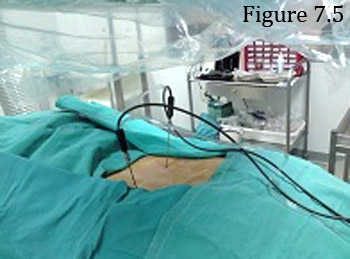Intradiscal Biacuplasty
In a recent well-designed investigation, researchers demonstrated that intradiscal biacuplasty, which is a minimally invasive procedure that uses radiofrequency energy to treat the annular tear component of the disc herniation, was superior (P<0.05) to a sham (fake) biacuplasty procedure for the treatment of chronic disc-herniation-related low-back pain. [1]
 Specifically, Kapural et al. [1] reported the six-month results of their randomized, placebo-controlled trial (this type of design produces very high quality scientific evidence) that randomly (the patient got assigned to a group by luck of the draw) placed 64 chronic-pain-suffering patients (all of whom were diagnosed with lumbar discogenic pain) into either a real or fake biacuplasty treatment group.
Specifically, Kapural et al. [1] reported the six-month results of their randomized, placebo-controlled trial (this type of design produces very high quality scientific evidence) that randomly (the patient got assigned to a group by luck of the draw) placed 64 chronic-pain-suffering patients (all of whom were diagnosed with lumbar discogenic pain) into either a real or fake biacuplasty treatment group.
The fake biacuplasty procedure put the patient through the same preoperative and operative steps as the real biacuplasty procedure, which included poking the cannulas through the muscles of the low back. (figure 7.5) However, the machine that generated the RF current (this current is used to cauterize the annular tear closed) was rigged so that no current was flowing. In other words, the machine was not working.
The beauty of this study design was that neither the patients nor the patient's treating doctors knew whether or not the real biacuplasty have been performed (this is called blinding) until after the six-month evaluation.
At the six-month evaluation, patients from the real biacuplasty group reported a significant (p<0.05) decrease in their pain and increase in their ability to function, as compared to patients in the fake biacuplasty group. [1]
Part two of this investigation is now underway. Not only will clinical outcomes being checked again further on down the road, patients in the fake biacuplasty group were allowed to cross over (have the real procedure) and will be followed.
I eagerly await the results of their next evaluation and be sure to keep my readers updated and is most fascinating study. Will the original biacuplasty group keep that advantage with regard to outcomes? Will the crossover patients also achieve significant improvement from the real procedure? We will just have to wait and see.
*I want to publicly congratulate Kapural and his team of investigators for daring to put one of these experimental treatments through a "real" scientific study and strongly urge the patent-holders on IDET, SED, Nucleoplasty, discTRODE, and PIRFT, to begin their own studies with this same design, for until they do, I will not be able to recommend these procedures for the treatment of chronic back and/or leg pain.
References
1) Kapural L, Vrooman B, Sarwar S, et al. A randomized, placebo-controlled trial of transdiscal radiofrequency biacuplasty for treatment of discogenic low back pain. Pain Med 2013; 14:362-373.